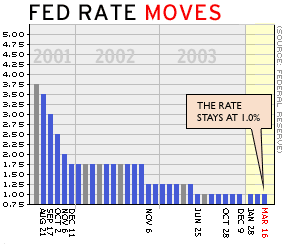NEW YORK (CNN/Money) -
The nation's economy is stronger and interest rates must rise eventually to keep inflation in check, Alan Greenspan said Wednesday, but the Fed chairman also seemed to suggest the central bank was in no hurry to raise them.
The threat of "disinflation," or a lack of corporate pricing power, seems to have faded, Greenspan said in remarks delivered to the Joint Economic Committee of Congress, though he also said inflation was still dormant because labor costs are flat.
"But the Federal Reserve recognizes that sustained prosperity requires the maintenance of price stability and will act, as necessary, to ensure that outcome," he added.
His remarks were, on the whole, more balanced about the risks of inflation than were comments he made on Tuesday, which raised fears in stock and bond markets that a Fed rate hike was imminent.
Still, many economists interpreted his comments on both days as part of a campaign to prepare investors for an eventual return to higher rates.
"The Chairman (over the two days) was surprisingly hawkish, and we should be ready for rate hikes as soon as the data justify them," said Steve Stanley, economist at RBS Greenwich Capital Markets.

On Wall Street, stocks recovered from early declines to trade mixed after Greenspan spoke, as investors were encouraged by his apparent lack of urgency about inflation. Treasury bond prices were also mixed. Stocks and bond prices fell Tuesday after Greenspan's remarks on deflation sparked concerns about rising rates.
Trading in the fed funds futures market indicated investors were betting on a 50 percent chance that Fed policy-makers would raise short-term rates in June, and a 100 percent chance in August, both slightly higher than the start of the week.
In a way, the mixed reaction reflected the dual nature of Greenspan's remarks, which offered some support both to economists expecting an early rate hike and to those expecting a later move.
"In total, we learned very little about the future of the economy or Fed policy except that the Fed is not ready to hike rates in the very near future," said Ethan Harris, chief economist at Lehman Brothers, which still expects the first rate hike in September.
Economy improving, but some slack remains
In listing signs of an economic acceleration this year, Greenspan cited a faster rate of growth in gross domestic product (GDP), strong consumer and business spending, a recovery in factory output, a bounce in exports, and a labor market that's "gradually improving."
"Looking forward, the prospects for sustaining solid economic growth in the period ahead are good," he said.
But he also warned that businesses still seemed cautious about spending on factory improvements, inventory building and hiring. He also noted that the recent boom in productivity, or output per worker hour, wasn't quite over yet, as companies continue to use technology to run more efficiently.
If demand is still strong when that process finally runs its course, Greenspan said, then hiring will need to accelerate, putting upward pressure on wages and, eventually, consumer prices. Nevertheless, he indicated that such inflation wasn't exactly right around the corner.
"Still-significant productivity growth and a sizable margin of underutilized resources, to date, have checked any sustained acceleration of the general price level and should continue to do so for a time," he said.
Greenspan hints at continued patience
Fed policy-makers are scheduled to meet May 4 to discuss the economy and their target for the federal funds rate, an overnight bank lending rate that influences other rates throughout the economy. Few analysts expect a rate increase at that meeting, but market participants expect a rate hike to come at the Fed's August policy meeting.
Facing the threat of deflation in a recession and the subsequent sluggish recovery, the Fed cut its fed funds target 13 times starting early in 2001, taking the fed funds rate to its lowest level in more than 40 years.
Most economists believe the current level of the fed funds rate is too low and that rates could rise a little and still accommodate economic growth. Recent economic data -- including a surge in payroll growth, consumer price inflation and retail sales in March -- have pushed markets to expect a rate hike sooner rather than later.
The Fed has said for months that it can be "patient" about raising rates, and economists have struggled to figure out what "patient" means. Some policy-makers have suggested that the definition could extend to a slow increase in rates.
Greenspan, in response to a lawmaker's question, hinted that such an approach was possible, that the Fed wouldn't necessarily need to make several rate increases in a row, as many market participants fear.
"There have been many occasions on which we've made one move and stopped," he said.
Some analysts worry the Fed is falling behind the curve, that it's letting inflation pressures build and will be forced to raise rates quickly and dangerously to catch up. A weakening dollar and surging commodity prices, for example, are often cited as harbingers of higher prices.
Greenspan acknowledged those signs of inflation in his testimony, but pointed out that labor costs make up about two-thirds of total business costs and that broader consumer price inflation would stay in check until productivity growth slowed and labor costs rose. And inflation may wait even longer than that, hurting corporate earnings first.
"The initial effect of a slowing of productivity growth is more likely to be an easing of profit margins than an acceleration of prices," he said in his prepared remarks.

|